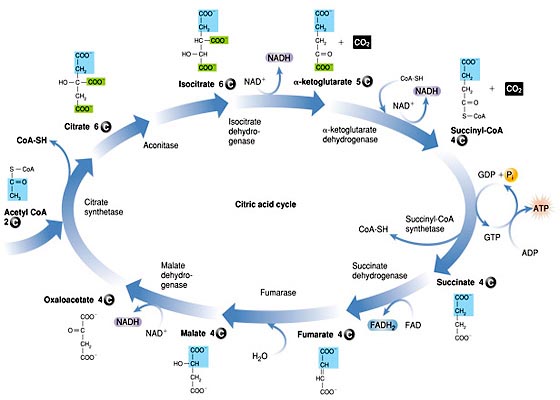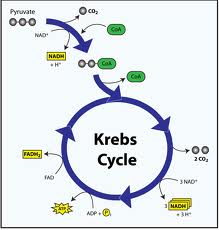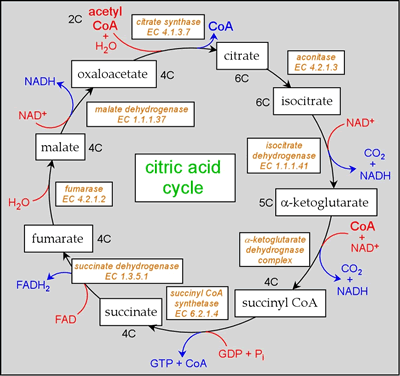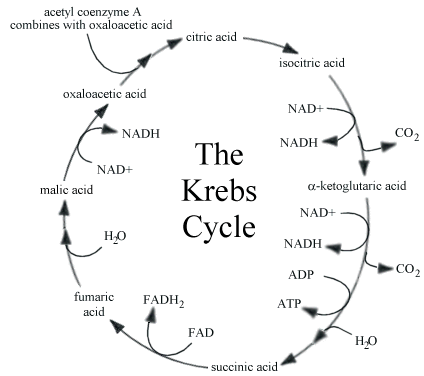Cellular Respiration - Krebs Cycle Quiz

Welcome to the "Cellular Respiration - Krebs Cycle Quiz"! This quiz is designed to assess your understanding of one of the central metabolic pathways in cellular respiration, the Krebs Cycle, also known as the citric acid cycle or TCA cycle, the second important process in cellular respiration. It takes place within the mitochondria of animal, plant, and along the cell membranes of bacteria. It would be very helpful for you to review the cycle reference sheet.
In this quiz, you will be challenged with a series of thought-provoking questions that cover various aspects of the Krebs Cycle. Whether you are Read morea biology student, a science enthusiast, or anyone seeking to deepen their knowledge of cellular metabolism, this quiz offers an engaging way to test your comprehension of the Krebs Cycle. The questions are thoughtfully designed to challenge your grasp of concepts while aiding your learning journey. We encourage you to take the quiz, challenge yourself, and discover how well you know the intricate details of the Krebs Cycle. Best of luck!
As "fill-in" questions appear in this test, please enter your answer(s) using all lower case letters. Unless, the question site provides you with different instructions.
- 1.
What molecule is formed after isocitrate looses a carbon atom to Carbon Dioxide?
- A.
Succinate
- B.
Guanosine Triphosphate
- C.
Alpha-ketoglutarate
- D.
Pyruvate
- E.
Fumarate
Correct Answer
C. Alpha-ketoglutarateExplanation
When isocitrate loses a carbon atom in the form of carbon dioxide (CO2), it undergoes a chemical reaction within the citric acid cycle (also known as the Krebs cycle or TCA cycle). The resulting molecule is called alpha-ketoglutarate or α-ketoglutarate.Rate this question:
-
- 2.
4 molecules of Carbon Dioxide are released in 2 turns of the Krebs Cycle to convert both molecules of pyruvate from glycolysis. (Please use cycle below to obtain correct answer.)
- A.
True
- B.
False
Correct Answer
A. TrueExplanation
Glycolysis produces two molecules of pyruvate from one molecule of glucose.
Each molecule of pyruvate entering the Krebs cycle releases one molecule of carbon dioxide.
Therefore, two molecules of pyruvate entering the Krebs cycle will release two molecules of carbon dioxide.
However, the complete oxidation of glucose requires two turns of the Krebs cycle to process both pyruvate molecules generated from one glucose molecule.
In two turns of the Krebs cycle, a total of four molecules of carbon dioxide are released (two from each pyruvate molecule).
Therefore, the statement is true: 4 molecules of carbon dioxide are released in 2 turns of the Krebs cycle to convert both molecules of pyruvate from glycolysis.Rate this question:
-
- 3.
Which one of the following acids is NOT found in Krebs Cycle.
- A.
Citric Acid
- B.
Fumaric Acid
- C.
Hydrochloric Acid
- D.
Malate
Correct Answer
C. Hydrochloric AcidExplanation
Key acids in the Krebs Cycle: Citric acid (citrate), α-ketoglutaric acid (α-ketoglutarate), succinic acid (succinate), fumaric acid (fumarate), malic acid (malate), oxaloacetic acid (oxaloacetate).Rate this question:
-
- 4.
Acetyl CoA is broken down to produce hydrogen atoms, ATP, and Carbon Monoxide.
- A.
True
- B.
False
Correct Answer
B. FalseExplanation
Acetyl CoA is broken down in the Krebs Cycle to produce carbon dioxide (CO2), energy-rich molecules NADH and FADH2, and a small amount of ATP through substrate-level phosphorylation.Rate this question:
-
- 5.
How many carbon atoms does isocitrate have in its structure? (Hint: enter a number from 0 to 10.)
Correct Answer
6Explanation
Isocitrate contains 6 carbon atoms, making it a 6-carbon compound in the Krebs Cycle, a central metabolic pathway. It's an intermediate formed from citrate and plays a role in energy production.Rate this question:
- 6.
Pyruvic Acid molecules have 6 carbon atoms.
- A.
True
- B.
False
Correct Answer
B. FalseExplanation
Pyruvic acid consists of three carbon atoms, making it a three-carbon compound formed during glycolysis, a key step in glucose metabolism.Rate this question:
-
- 7.
How many adenosine triphosphate molecules are produced by the Krebs Cycle after the complete breakdown of pyruvate molecules?
- A.
20
- B.
10
- C.
6
- D.
12
Correct Answer
B. 10Explanation
After the complete breakdown of one pyruvate molecule, 10 ATP molecules are produced through the processes associated with the Krebs Cycle, including the electron transport chain's contribution from NADH and FADH2 generated by the cycle. This takes into account the typical ATP yield values from oxidative phosphorylation, reflecting efficiencies seen in eukaryotic cells.Rate this question:
-
- 8.
How many times must the Krebs Cycle run to completely use 1 molecule of glucose?
- A.
1 time
- B.
2 times
- C.
3 times
- D.
6 times
Correct Answer
B. 2 timesExplanation
The Krebs Cycle needs to run twice to completely utilize one molecule of glucose. This is because glucose is initially broken down into two molecules of pyruvate through glycolysis, and each pyruvate molecule enters the Krebs Cycle separately, resulting in two turns of the cycle for one glucose molecule.Rate this question:
-
- 9.
What cellular organelle does the Krebs Cycle take place?
- A.
Golgi Apparatus
- B.
Mitochondria
- C.
Nucleus
- D.
Plasma Membrane
Correct Answer
B. MitochondriaExplanation
The Krebs Cycle takes place in the mitochondria, a cellular organelle responsible for producing energy through various metabolic processes, including the citric acid cycle (Krebs Cycle) and oxidative phosphorylation.Rate this question:
-
- 10.
Which one of these molecules are formed before alpha Ketogluterate in the Krebs Cycle?
- A.
Acetic Acid
- B.
Citrate
- C.
Fumarate
- D.
Maleate
Correct Answer
B. CitrateExplanation
In the Krebs Cycle, citrate molecules are formed before alpha-ketoglutarate. The cycle begins with the condensation of acetyl-CoA and oxaloacetate to form citrate. Subsequent reactions then lead to the conversion of citrate into other intermediates, eventually resulting in the formation of alpha-ketoglutarate.Rate this question:
-
- 11.
Succinyl-CoA is not found in the Krebs Cycle.
- A.
True
- B.
False
Correct Answer
B. FalseExplanation
Succinyl-CoA is an intermediate molecule found in the Krebs Cycle (citric acid cycle). It is formed during the conversion of alpha-ketoglutarate to succinate in the cycle.Rate this question:
-
- 12.
How many carbon atoms are found in a molecule of fumarate? (Please enter your answer in numerals.)
Correct Answer
4Explanation
Fumarate contains four carbon atoms, making it a four-carbon compound in the Krebs Cycle.Rate this question:
- 13.
Which electron acceptor molecule aids in the transformation of succinate to fumarate?
- A.
ADP - ATP
- B.
FAD - FADH2
- C.
GDP - GTP
- D.
NAD+ - NADH
Correct Answer
B. FAD - FADH2Explanation
The electron acceptor molecule that aids in the transformation of succinate to fumarate in the Krebs Cycle is FAD (flavin adenine dinucleotide). It is reduced to FADH2 during this reaction.Rate this question:
-
- 14.
Which one of the following molecules is not a 4 carbon molecule found in Krebs Cycle.
- A.
Fumarate
- B.
Succinate
- C.
Maleate
- D.
Citrate
Correct Answer
D. CitrateExplanation
Citrate contains six carbon atoms.Rate this question:
-
- 15.
How many carbon atoms are found in the molecule Oxaloacetate? (Hint: please use numerals from 0 to 12.)
Correct Answer
4Explanation
Oxaloacetate is a four-carbon molecule.Rate this question:
- 16.
How many times are the CoA-SH molecules released during 2 turns of Krebs Cycle? (Hint: please use numerals from 0 to 12.)
Correct Answer
4Explanation
During 2 turns of the Krebs Cycle, CoA-SH molecules are released 4 times. Each turn releases one CoA-SH molecule when acetyl-CoA is condensed with oxaloacetate to form citrate, and another CoA-SH molecule when succinyl-CoA is converted to succinate.Rate this question:
- 17.
Which one of the following molecules are produced first by the Krebs Cycle?
- A.
Malate
- B.
Isocitrate
- C.
Citric Acid
- D.
Fumarate
Correct Answer
C. Citric AcidExplanation
The Krebs Cycle initiates with the combination of acetyl-CoA and a four-carbon molecule known as oxaloacetate (OAA). This union leads to the formation of citric acid, a six-carbon compound, which is why the Krebs Cycle is sometimes referred to as the citric acid cycle.Rate this question:
-
- 18.
What molecules are used to transform Succinyl-CoA into Succinate?
- A.
AMP and GDP
- B.
GTP and ATP
- C.
CoA-SH and ATP
- D.
CoA-SH and GDP
Correct Answer
B. GTP and ATPExplanation
GTP and ATP are molecules used to transform Succinyl-CoA into Succinate. GTP (guanosine triphosphate) and ATP (adenosine triphosphate) are both high-energy molecules that provide the necessary energy for the conversion process. CoA-SH (coenzyme A thiol) is not directly involved in this specific transformation, and GDP (guanosine diphosphate) is not used in the process either.Rate this question:
-
- 19.
What molecule(s) are released in the formation of alpha-Ketogluterate into Succinyl-CoA?
- A.
FAD --> FADH2
- B.
NAD+ --> NADH + CO2
- C.
FAD --> FADH2 + HOH
- D.
NADH + CO2
Correct Answer
D. NADH + CO2Explanation
In the reaction that converts alpha-ketoglutarate into succinyl-CoA within the Krebs Cycle, one molecule of carbon dioxide (CO2) is released, along with the reduction of a molecule of nicotinamide adenine dinucleotide (NAD+) to form NADH. This reaction is catalyzed by the enzyme alpha-ketoglutarate dehydrogenase complex.Rate this question:
-
- 20.
Using the diagram attached to this question, which molecule is found between citrate and isocitrate?
- A.
Succinyl-CoA
- B.
Alpha-Ketogluterate
- C.
Cis-Aconitate
- D.
Malate
Correct Answer
C. Cis-AconitateExplanation
The diagram attached to the question shows the citric acid cycle, also known as the Krebs cycle. This cycle involves a series of chemical reactions that occur in the mitochondria of cells. The molecule found between citrate and isocitrate in this cycle is cis-Aconitate. This molecule is formed from citrate through a dehydration reaction and is then converted to isocitrate. Therefore, cis-Aconitate is the correct answer.Rate this question:
-
- 21.
The enzyme fumarase is used in Krebs Cycle to form malate.
- A.
True
- B.
False
Correct Answer
A. TrueExplanation
The enzyme fumarase (also known as fumarate hydratase) is used in the Krebs Cycle to convert fumarate into malate. This reaction involves the addition of a water molecule to fumarate, resulting in the formation of malate.Rate this question:
-
- 22.
Which molecule is formed after succinyl-CoA?
- A.
Malate
- B.
Fumarate
- C.
Citrate
- D.
Succinate
Correct Answer
D. SuccinateExplanation
Succinyl-CoA is converted into succinate through a series of enzymatic reactions in the citric acid cycle. Succinate is an important intermediate molecule in this cycle, and it plays a key role in the production of energy through cellular respiration. Therefore, the correct answer is Succinate.Rate this question:
-
- 23.
Water is used as a reactant in Krebs Cycle before carbon dioxide.
- A.
True
- B.
False
Correct Answer
B. FalseExplanation
Water is not used as a reactant in the Krebs Cycle before carbon dioxide. In the Krebs Cycle, also known as the citric acid cycle, the reactants are acetyl-CoA and oxaloacetate. These reactants undergo a series of chemical reactions that result in the production of carbon dioxide, ATP, and reduced electron carriers such as NADH and FADH2. Water is not directly involved as a reactant in this cycle. Therefore, the statement is false.Rate this question:
-
- 24.
Fumarate, malate, and citrate all have 4 carbon atoms.
- A.
True
- B.
False
Correct Answer
B. FalseExplanation
Fumarate and malate have four carbon atoms each, while citrate has six carbon atoms.Rate this question:
-
Quiz Review Timeline +
Our quizzes are rigorously reviewed, monitored and continuously updated by our expert board to maintain accuracy, relevance, and timeliness.
-
Current Version
-
Apr 22, 2024Quiz Edited by
ProProfs Editorial Team
Expert Reviewed by
Stephen Reinbold -
Nov 07, 2010Quiz Created by
John Mitchell
 Back to top
Back to top



.jpg)

.jpg)
.jpg)
.jpg)
.jpg)

.jpg)
.jpg)


.jpg)
.jpg)